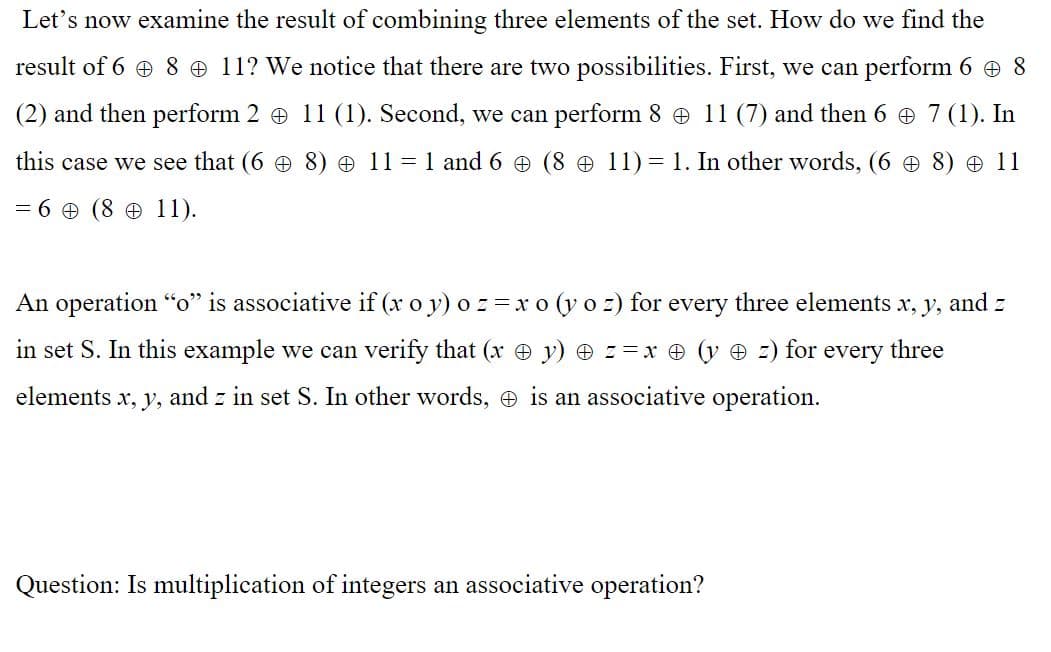Let's now examine the result of combining three elements of the set. How do we find the result of 6 + 8 + 11? We notice that there are two possibilities. First, we can perform 68 (2) and then perform 2 11 (1). Second, we can perform 8 11 (7) and then 6 + 7 (1). In this case we see that (68) 11 = 1 and 6 (8 11) = 1. In other words, (68) + 11 = 6 (811). An operation "o" is associative if (x oy)oz=xo (yoz) for every three elements x, y, and z in set S. In this example we can verify that (x + y) + z = x (y z) for every three elements x, y, and z in set S. In other words, is an associative operation.
Let's now examine the result of combining three elements of the set. How do we find the result of 6 + 8 + 11? We notice that there are two possibilities. First, we can perform 68 (2) and then perform 2 11 (1). Second, we can perform 8 11 (7) and then 6 + 7 (1). In this case we see that (68) 11 = 1 and 6 (8 11) = 1. In other words, (68) + 11 = 6 (811). An operation "o" is associative if (x oy)oz=xo (yoz) for every three elements x, y, and z in set S. In this example we can verify that (x + y) + z = x (y z) for every three elements x, y, and z in set S. In other words, is an associative operation.
Chapter9: Sequences, Probability And Counting Theory
Section9.5: Counting Principles
Problem 36SE: The number of 5-element subsets from a set containing n elements is equal to the number of 6-element...
Related questions
Question

Transcribed Image Text:Let's now examine the result of combining three elements of the set. How do we find the
result of 6 8 11? We notice that there are two possibilities. First, we can perform 68
(2) and then perform 2 11 (1). Second, we can perform 8 11 (7) and then 6 + 7 (1). In
this case we see that (68) + 11 = 1 and 6 + (8 + 11) = 1. In other words, (6 + 8) + 11
= 6 (8 11).
An operation "o" is associative if (xoy)oz=xo (yoz) for every three elements x, y, and z
in set S. In this example we can verify that (x + y) + z = x + (y + z) for every three
elements x, y, and z in set S. In other words, is an associative operation.
Question: Is multiplication of integers an associative operation?
Expert Solution
This question has been solved!
Explore an expertly crafted, step-by-step solution for a thorough understanding of key concepts.
Step by step
Solved in 2 steps

Recommended textbooks for you


College Algebra (MindTap Course List)
Algebra
ISBN:
9781305652231
Author:
R. David Gustafson, Jeff Hughes
Publisher:
Cengage Learning

Algebra: Structure And Method, Book 1
Algebra
ISBN:
9780395977224
Author:
Richard G. Brown, Mary P. Dolciani, Robert H. Sorgenfrey, William L. Cole
Publisher:
McDougal Littell


College Algebra (MindTap Course List)
Algebra
ISBN:
9781305652231
Author:
R. David Gustafson, Jeff Hughes
Publisher:
Cengage Learning

Algebra: Structure And Method, Book 1
Algebra
ISBN:
9780395977224
Author:
Richard G. Brown, Mary P. Dolciani, Robert H. Sorgenfrey, William L. Cole
Publisher:
McDougal Littell

Algebra & Trigonometry with Analytic Geometry
Algebra
ISBN:
9781133382119
Author:
Swokowski
Publisher:
Cengage